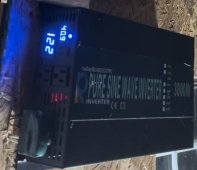ClinicalScientist
New Member
- Joined
- Feb 21, 2022
- Messages
- 25
Hello Solar friends!
I’ve been a long time lurker and finally posting looking for for advice. As many people have posted: I am attempting to charge my EV from my setup, but am getting an insufficient grounding error. I know the EV charger is simply checking for a connection from ground to neutral (usually back at the panel for home systems). I know you can also create a bonding plug allowing this to work. I have an XYZ INVT 1500 watt pure sine inverter. After doing some research I became concerned about doing this with this particular inverter. It appears to me that both neutral and the HOT sides are putting out 60 volts with the ground simply a chassis ground. My questions are:
Can I safely bond the neutral to ground with this setup? I also run a GFCI with the setup.
Should I just return this inverter and get one where only the hot side is 120 volts and the neutral is 0v so I can bond the neutral safely?
Thank you so much for your advice in advance. Also note this system is not connected to shore power or a home system and is designed to be mobile.
I’ve been a long time lurker and finally posting looking for for advice. As many people have posted: I am attempting to charge my EV from my setup, but am getting an insufficient grounding error. I know the EV charger is simply checking for a connection from ground to neutral (usually back at the panel for home systems). I know you can also create a bonding plug allowing this to work. I have an XYZ INVT 1500 watt pure sine inverter. After doing some research I became concerned about doing this with this particular inverter. It appears to me that both neutral and the HOT sides are putting out 60 volts with the ground simply a chassis ground. My questions are:
Can I safely bond the neutral to ground with this setup? I also run a GFCI with the setup.
Should I just return this inverter and get one where only the hot side is 120 volts and the neutral is 0v so I can bond the neutral safely?
Thank you so much for your advice in advance. Also note this system is not connected to shore power or a home system and is designed to be mobile.




